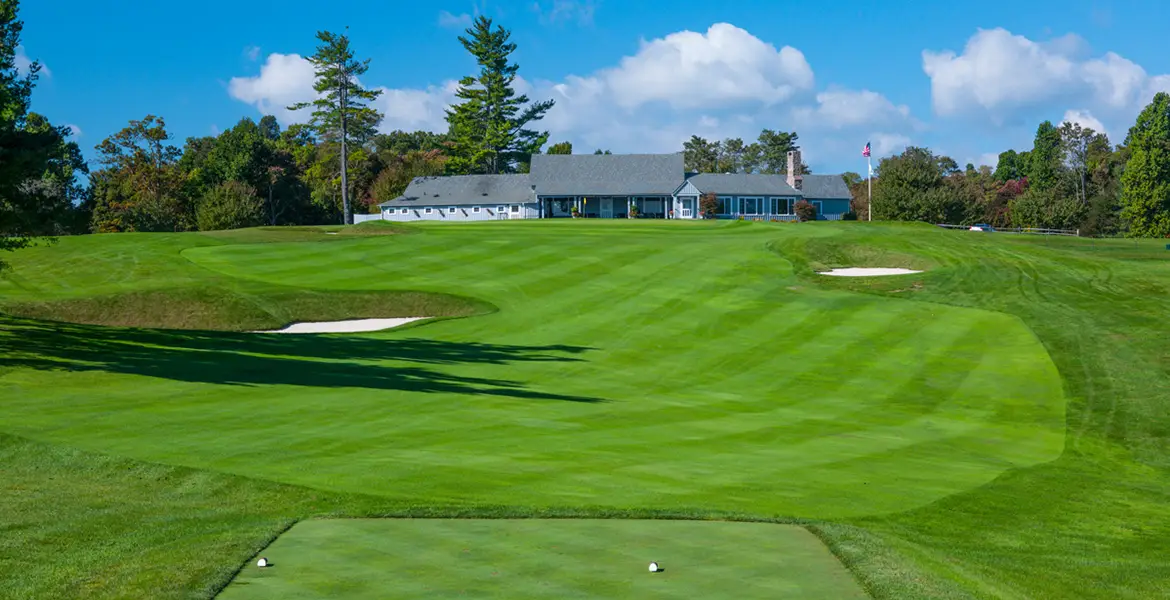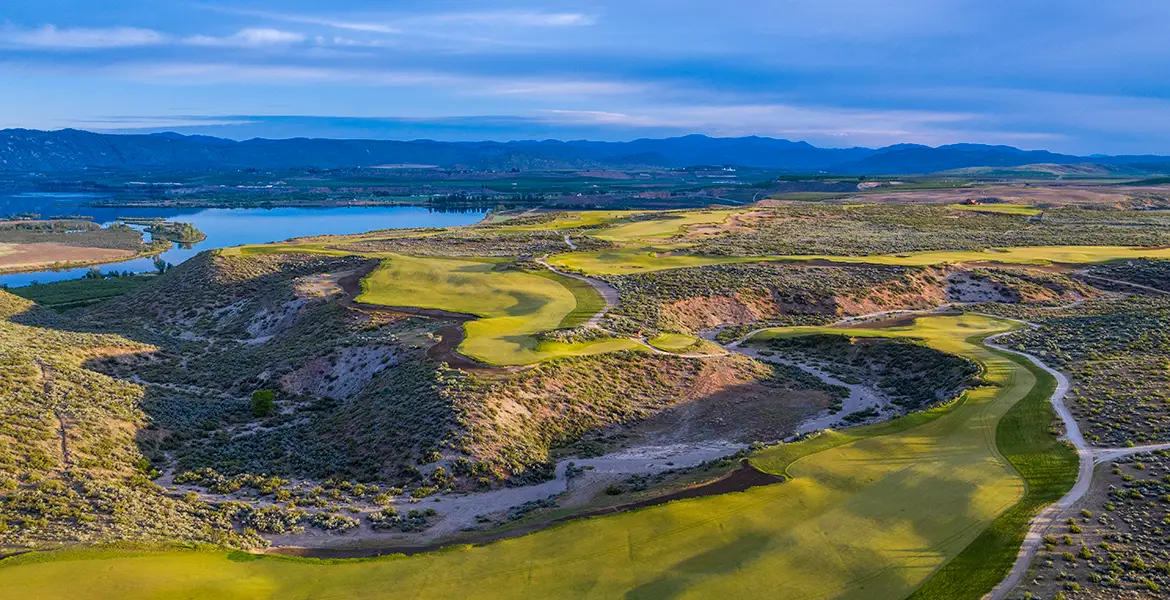Nine-holers, Par-3s, and other abbreviated courses are all the rage–and could be the secret to reviving golf
Former U.S. Open champion Geoff Ogilvy missed the cut at the 2009 British Open, but that didn’t prevent him from making lasting memories that week. Each day, after practice and following his first two rounds at the Ailsa Course at Turnberry Resort, he grabbed a putter, a sand wedge, and a pint of beer and did several laps around the Wee Links, an 18-hole pitch-and-putt course set alongside the glorious Ayrshire coastline that is designed to play like a mini-Ailsa.
“Does it get any better than that?” Ogilvy asks.
Short courses and nine-hole courses have long served as the sandlots of golf while also being regarded as the game’s red-headed stepchild. Now, suddenly, they are all the rage.
Among the alternative-length courses to open at famous resort destinations in the last year are The Cradle at Pinehurst and The Roundabout at Streamsong, with The Sandbox at Sand Valley debuting May 1. And the architects lending their imagination to shaping these small wonders are the crème de la crème of the profession. Even Tiger Woods and Jordan Spieth have gotten into the act helping to elevate the status of the short course.

What’s driving this mini-revolution? Less time consuming, less difficult, less expensive, less use of water and pesticides, and more family-friendly for golfers of all skill levels, short courses check all the boxes for what is required for golf to grow in this day and age.
“For me, it’s so obvious. I don’t understand why they aren’t everywhere,” says Ogilvy, who renovated The Little Nine at Shady Oaks in Ft. Worth, Texas, where Ben Hogan used to dig it out of the dirt.
Short courses have been around almost as long as the game itself. Ogilvy points to North Berwick, in East Lothian, Scotland—the 13th oldest club in the world—and its neighboring children’s course, a nine-hole par-3 layout adjacent to the 15th and 16th holes on the West Links, as a model for the atmosphere, size, and scale of what is needed (to borrow a popular phrase) to make golf great again. Ogilvy loves the sign that greets golfers: “Adults can play only when accompanied by a child.”
“The Scots have had it worked out for 150 years,” Ogilvy says. “The rest of us? We’ve just found a way to mess it up.”
Somewhere along the way, it became accepted as one of golf’s Ten Commandments that the game consisted of bashing driver over a course of 18 holes. Playing nine developed a stigma, as if it didn’t count, and in a way it didn’t. A nine-hole handicap for local use only wasn’t permitted until 1960: A golfer could post a nine-hole score, but had to wait until another nine hole score was posted to be merged for an 18-hole score, and those nine-hole scores had to be consecutive.
Against that framework, golf’s small wonders have continued to provide an affordable entry point to the game and often as much charm as challenge. According to the National Golf Foundation, there are more than 4,000 nine-hole golf courses across the country, and more than 8,000 worldwide.
It wasn’t until 1998 that a nine-hole handicap index finally was acknowledged by the USGA. Another key moment in legitimizing the short course occurred in 2008 when Augusta National Golf Club gave nine-hole play the ultimate promotion by televising the Masters Par 3 Contest.
Many industry observers point to Bandon Preserve—the 13-hole course designed in 2012 by Bill Coore and Ben Crenshaw that begins high above a southern Oregon sand dune and rolls down toward the Pacific Ocean—as the one that made short courses cool again. Before Bandon Dunes, developer Mike Keiser’s first course was The Dunes Club, a private nine-hole par-3 course that opened in New Buffalo, Mich., in 1990. Keiser originally purchased the land to block a condominium development near his summer home on the banks of Lake Michigan, but eventually he bought another adjacent plot and hired Dick Nugent to lay out the holes. There are no tee markers at this walking-only course, and the local rule is that the winner of the previous hole gets to choose where to tee off on the next one.
Bandon Preserve was conceived as a breather for the golfer walking 36 holes day after day at the resort’s four standout 18-hole layouts, while giving another option to the golfer who didn’t want to sit in his room all afternoon, either. Keiser says his inspiration for the Preserve was The Horse Course, a course with no tees, just expanded fairways and 10 greens, at the Prairie Club in Nebraska. Designed by Gil Hanse with Jim Wagner and Geoff Shackelford, the trio took the concept of basketball’s game of “horse,” which allows the winner of each hole to choose the stance, lie, shot, and green for the next hole.
“We just thought, ‘How much fun would that be to be able to build a little course where the opportunity existed for any number of different shots to be played,’” Hanse says.
The popularity of Bandon Preserve, which is about as much fun as can be had without a wood in the bag, led to Keiser building the 17-hole Sandbox at Sand Valley, and he has announced plans for a short course at Cabot Links in Canada.
Short courses address the growing question of time and the shift in priorities over how to spend it. Bass Pro Shops founder Johnny Morris isn’t an avid golfer, but he recognizes how golf can be a means to connect people to nature and bring families together. The most popular family activity at his sprawling Big Cedar Lodge Resort set in the Ozark Mountains is Putt-Putt golf. (Of course, there is a hole where you putt through the mouth of a bass rather than a clown.) The resort’s first course, the Jack Nicklaus-designed Top of the Rock, is a splashy par-3 layout that holds the honor of being the first nine-hole, par 3 to host a PGA Tour tournament as the home of the PGA Tour Champions Legends of Golf. In 2017, Gary Player designed a second short course at Big Cedar Lodge, the 13-hole Mountain Top layout, a walking-only course without forced carries that challenges seasoned players while also being fun and welcoming for new golfers. Morris expects it will do as many rounds as Top of the Rock, which is cart-path-only.

“If we can have a course that is the next step above putt-putt, then the whole family can come and play,” Morris says.
And Morris isn’t done. As part of his deal to build an 18-hole layout on property, Tiger Woods also will design a short course at Big Cedar Lodge Resort, just as he has built a 10-hole, 792-yard, par-30 course named The Playgrounds at Bluejack National Golf Club in Montgomery, Texas, and the 12-hole Oasis Short Course at Diamante in Cabo San Lucas, Mexico.
This is full circle for Tiger, whose first home track was Heartwell Golf Course, a par-3 layout in Long Beach, Calif., where at age eight he made his first hole-in-one, ran to the green, and celebrated before realizing he’d left his bag on the tee. Woods has made the short course a staple of his course-design philosophy, announcing in March 2017 that he is building a short course at Jack’s Bay, a private development in The Bahamas. Likewise, Jordan Spieth collaborated with architect Roy Bechtol on the Spieth Lower 40, a six-hole par-3 course built on 4½ acres between the members’ range and the first hole at the University of Texas Golf Club.
“Not to take anything away from the Mike Keisers of the world, but when Jordan Spieth and Tiger Woods are designing short courses and rubber-stamping them, that means a lot,” says Shackelford.
If fun is the operative word for these short courses, Bob Parsons, the founder of equipment-maker PXG and internet domain registrar GoDaddy, took a contrarian’s approach, instructing architects Jackson-Kahn Design to build the world’s hardest par-3 course at his Scottsdale National Golf Club.
“They’re all completely unfair,” Parsons says of the holes at The Bad Little Nine. “You would think, okay, well, who’s going to want to play that? The answer to that is everybody.”
The fun—or in this case torture—ratchets up on Challenge Day. Every Friday, Parsons has a standing $1,000 offer to anyone who can break par when the course is all tricked out. Ogilvy tried once and walked off the first hole after his 10th stroke.

Will this little trend have legs? Golf Digest architectural editor Ron Whitten views short courses as loss leaders that don’t work as stand-alone businesses. He speaks from experience. In 1999, Whitten built Safari Golf, a nine-hole, lit pitch-n-putt where the longest hole was 90 yards, in Topeka, Kan., next to an existing driving range and miniature golf operation. It lasted just three years. Whitten notes that all the reasons short courses should thrive ignores the elephant in the room.
“It still requires daily maintenance, a superintendent, and a crew,” Whitten explains. “That’s an enormous expense for any golf operation, and cost prohibitive if you’re just doing a short course.”
Rob Collins of King-Collins Design & Golf Construction is the architect and owner-operator of Sweetens Cove Golf Club, a quirky, strategic, nine-hole course that officially opened in April 2015 in South Pittsburg, Tenn., population 3,000. Anthony Pioppi, author of The Finest Nines, tabbed Sweetens Cove “without a doubt, the finest 9-hole golf course built in the modern era of golf course architecture (post-1959).” Collins is convinced that nine-hole golf and short courses will continue to gain in popularity. He’s put his money where his mouth is and says Sweetens Cove—with 10 million people within a two-hour radius—will succeed because of its strong regional appeal.
“Demographics and the proximity to large population centers make the numbers work,” he says. “If you have those key elements on your side, there’s no question that nine holes can work as a standalone business.”
And what of Collins’s next design project, set to break ground this spring?
“It’s another nine-hole course,” he says.

The Top 10 Par-3 Courses
1: Bandon Preserve at Bandon Resort – Bill Coore & Ben Crenshaw (2012) Proof that great things come in small packages. With some of the best greens—and vistas —on property.
2: Augusta National Par-3 Course at Augusta National Golf Club – George Cobb (1958) As sure as the azaleas bloom each spring, this little gem hosts the annual Masters Par-3 Contest.
3: Top of the Rock at Big Cedar Resort & Lodge – Jack Nicklaus (2014) Gary Player ranks it ahead of Augusta’s par-3 course. We won’t go that far, but spectacular in its own right.
4: The Short Course at Pine Valley Golf Club – Ernie Ransome & Tom Fazio (1992) Offers miniaturized versions of some of the best shots on America’s top-ranked golf course.
5: The Cliffs Course at The Olympic Club – Jay Morrish & Tom Weiskopf (1994) The best layout at Olympic? Good luck not being distracted by the beauty of the Pacific Ocean—or the hang gliders.
6: Threetops at Treetops Resort – Rick Smith (1992) For a number of years, Threetops hosted the ESPN Par 3 Shootout. In 2001, Lee Trevino aced No. 7 for $1 million.
7: The Hickory Course at Hamilton Farm Golf Club – Mike Hurdzan & Dana Fry (2001) During a summer stay in 2001, Tiger Woods and Michael Jordan played it twice a day and the 18-hole big course once a day.
8: The Horse Course at The Prairie Club – Gil Hanse, Jim Wagner, & Geoff Shackelford (2010) Ten greens, no tee boxes, and it’s H-O-R-S-E for golf—win a hole and choose how you play the next one.
9: The Cradle Short Course at Pinehurst Resort – Gil Hanse (2017) Mere steps from the clubhouse are 789 yards of the most fun you’ll have at the “Cradle of American Golf.”
10: Bad Little Nine at Scottsdale National Golf Club – Tim Jackson & David Kahn (2016) Prepare to laugh at yourself as you get your teeth kicked in at the hardest par-3 course on the planet.








Check out the Preserve at Boulder Hills 18 hole par 3